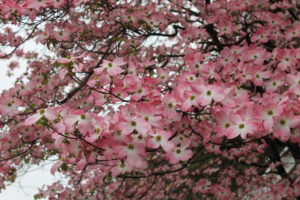Dogwood Comeback?
May 2nd, 2017
Is it just me, or did the dogwoods look better this spring than they have in a long time?
Our native American dogwood (Cornus florida) can be as showy as any tree when it blooms in white, pink or rose in April. This year’s show was particularly stunning – especially the dark-pink ones that I suspect are mostly ‘Cherokee Chief.’
The wacky late-winter/early-spring weather didn’t seem to faze dogwoods at all. In fact, the performance got me wondering if maybe the American dogwood is heroically overcoming the numerous attacks it’s faced in the last 20 to 30 years.
The biggest challenge has been a disease called anthracnose that causes purple splotches on the leaves and leads to branch dieback.
Borers also sometimes tunnel into dogwood trunks, causing bark to flake, branches to die, and whole trees to fail.
Lately, dogwoods usually suffer from powdery mildew later in the season, causing a white-gray cast on the leaves that then browns the leaves, putting a damper on this tree’s otherwise glowing maroon fall foliage.
For sure, I still see a lot of dead, dying and thinning dogwoods. Once the heat of summer shows up, the drawbacks become more apparent.
But covered in those half-dollar-sized, four-petaled, cross-shaped April blooms, dogwoods make it easy to overlook the troubles under the hood.
I’ve shied away from recommending many American dogwoods because of the bug and disease threats, not to mention their dislike of the compact clay soil and full blaring sun where too many homeowners want to plant them.
After all, this is a species that wants to live in the humusy, mildly acidic understory or edge of a temperate forest. Next to your south-facing driveway is a far cry from the ideal.
Struggle though they might, dogwoods seem to be hanging in there well enough to put on some pretty amazing spring shows. So I might have to cut them a bit more slack.
If you’re thinking about adding a dogwood, jack up the survival odds by improving your lousy soil with a couple of inches of compost worked into a wide planting bed (at least 6 inches in diameter).
A site that gets some afternoon shade or that gets filtered light from taller surrounding trees also will help.
If you want to limit the odds of anthracnose, look for a white bloomer called ‘Appalachian Spring’ that hails from Maryland’s Catoctin Mountains. This one was found disease-free in a grove surrounded by anthracnose-infected brethren.
You might also consider the kousa dogwood, which is a non-native Chinese dogwood that’s also disease-resistant and more tolerant of clay soil and sun. This one gets warty, marble-sized fall fruits instead of the oval red berries of the American dogwood. It also has attractive bark that sloughs off to create a Dalmatian-like appearance, and it blooms a few weeks later than the American dogwood.
And a third option is the Rutgers-developed series of hybrid dogwoods – crosses between the American and kousa types that have the look of American dogwoods and the durability of kousa dogwoods. They all have cosmic names, such as Aurora, Constellation, Stellar Pink, Celestial, etc.
Most of the Rutgers hybrids are sterile, meaning no fruits. That’s a down side if you’re aiming to feed birds, but a plus if you don’t like “messy trees” or are looking for a small tree for next to the patio.
One last thing that’s curious about dogwoods… their name. Ever wonder why we call them dogwoods?
One story is that it comes from the Old English word “dag,” which was the word for a slender piece of wood (think “dagger”). Dogwoods supplied a good, hard source of slender wood for items like daggers, skewers and arrows, and so it morphed from “dagwood” to “dogwood.”
Another story has it that people used to boil dogwood branches to make a supposed tonic that could cure manage in dogs.
Take your pick. I’ll go with the first one.









